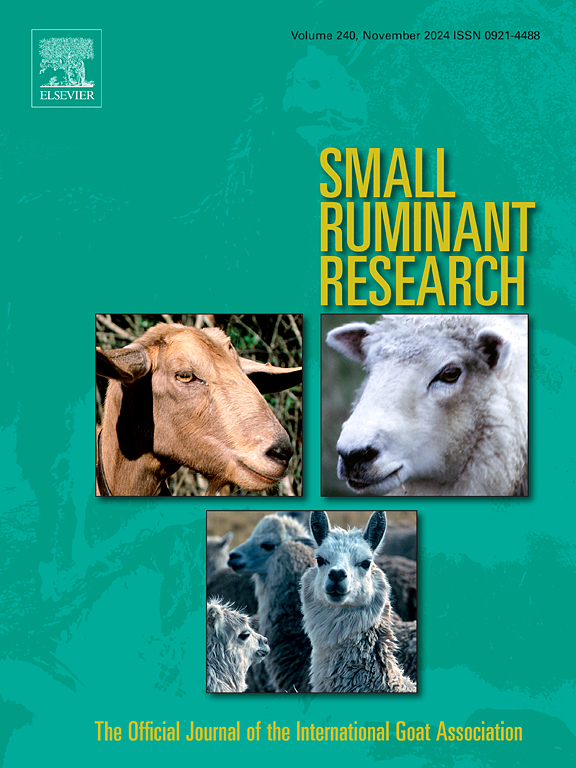非金黄色葡萄球菌在小反刍动物乳腺炎中的作用:对病因、危险因素、毒力决定因素和新治疗方法的系统回顾
IF 1.6
3区 农林科学
Q2 AGRICULTURE, DAIRY & ANIMAL SCIENCE
引用次数: 0
摘要
临床乳腺炎是导致牛奶发生物理、化学和细菌变化的主要因素,会导致重大的经济损失和福利损害。虽然小反刍动物的乳腺炎可以由各种感染因子和身体损伤引起,但细菌感染是主要原因。葡萄球菌,链球菌和大肠菌群被确定为乳腺炎的主要细菌病原体。引起乳腺炎的葡萄球菌通常分为金黄色葡萄球菌和非金黄色葡萄球菌(NAS)。NAS主要包括凝固酶阴性葡萄球菌(CNS),并选择凝固酶阳性和凝固酶可变葡萄球菌。NAS物种在其流行病学、致病性、毒力、生态位、宿主适应和抗菌素耐药性方面表现出变异性。它们与乳房微生物组组成的独特相互作用可能赋予对其他乳腺炎病原体的保护作用。在小型反刍动物中,NAS乳腺炎的治疗面临着抗生素耐药性和兽药供应有限等挑战。新兴的治疗方法包括噬菌体、益生菌、免疫疗法、植物化学物质、纳米技术和多肽。本文将讨论NAS作为小反刍动物乳腺炎病因的重要性,该群体的毒力因素,以及更大的科学研究范围,微生物组内物种水平的相互作用及其与宿主遗传学的相互作用对于阐明NAS在小反刍动物乳腺炎和乳房健康中的作用至关重要。本文章由计算机程序翻译,如有差异,请以英文原文为准。
The role of non-aureus Staphylococcus in small ruminant mastitis: A systemic review on etiological agents, risk factors, virulence determinants, and novel treatments
Clinical mastitis is a primary contributor to physical, chemical, and bacteriological changes in milk leading to significant economic loss and welfare impairment. While mastitis in small ruminants can be rooted in varied infectious agents and physical injuries, bacterial infections stand as the predominant cause. Staphylococci, Streptococci, and coliforms are identified as the primary bacterial pathogens responsible for mastitis. Mastitis-causing staphylococci are typically categorized into Staphylococcus aureus and non-aureus staphylococci (NAS). NAS encompasses mainly coagulase-negative Staphylococcus species (CNS) and selects coagulase-positive and coagulase-variable staphylococci. NAS species exhibit variability in their epidemiology, pathogenicity, virulence, ecological niche, host adaptation, and antimicrobial resistance profiles. Their unique interactions with the udder's microbiome composition may confer protection against other mastitis pathogens. In small ruminants, treatment for NAS mastitis faces challenges such as antibiotic resistance and limited availability of veterinary drugs. Emerging treatments include bacteriophages, probiotics, immunotherapy, phytochemicals, nanotechnology, and peptides. This review will discuss the importance of NAS as a cause of mastitis in small ruminants, the virulence factors of this group, and for greater scientific reach, the species-level interactions within the microbiome and its interplay with host genetics are crucial to elucidate the role of NAS in mastitis and udder health in small ruminants.
求助全文
通过发布文献求助,成功后即可免费获取论文全文。
去求助
来源期刊

Small Ruminant Research
农林科学-奶制品与动物科学
CiteScore
3.10
自引率
11.10%
发文量
210
审稿时长
12.5 weeks
期刊介绍:
Small Ruminant Research publishes original, basic and applied research articles, technical notes, and review articles on research relating to goats, sheep, deer, the New World camelids llama, alpaca, vicuna and guanaco, and the Old World camels.
Topics covered include nutrition, physiology, anatomy, genetics, microbiology, ethology, product technology, socio-economics, management, sustainability and environment, veterinary medicine and husbandry engineering.
 求助内容:
求助内容: 应助结果提醒方式:
应助结果提醒方式:


